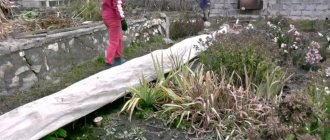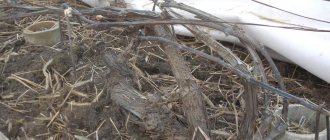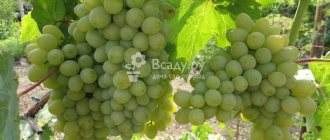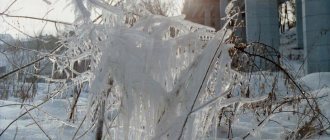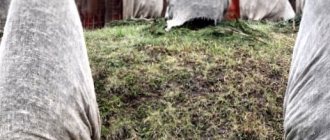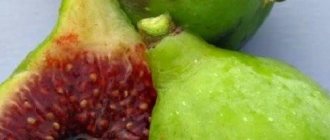- 41512
- grapes winter autumn
Preparing grapes for winter is a very important stage in their cultivation, since the safety of the plant and the next year’s harvest will depend on this.
It includes several stages: pruning, care, fertilizing, insulation.
Cover the grapes with soil
Earth or turf is the most accessible material for covering vines. With the onset of the first frosts, the grape bushes are covered with a 10-centimeter layer of material. After 3-4 weeks, the same volume is added. The soil for shelter is prepared in advance and stored dry in bags.
There is a significant drawback - the frost resistance of garden crops after such a winter decreases over time.
Proper preparation of grapevines for wintering
The grape bush begins to be prepared for winter while the berries are ripening. To do this, perform the following manipulations:
- Stop watering the grapes. This will stop the intensive growing season of the plant and switches it to the ripening of crops and wood.
- Phosphorus-potassium supplements are given. These elements help strengthen the plant, increase winter hardiness and accelerate the ripening of young shoots. Nitrogen is completely eliminated at this stage.
- After harvesting, pruning is done. All shoots that remain green are removed. Spent fruit vines are also pruned. After pruning, treat the bush with a solution of fungicides.
- Perform water-recharging irrigation. The purpose of the manipulation is to saturate the soil to the entire depth of the root layer, so that there are no voids left into which frosty air can penetrate.
Tip #1. Experienced winegrowers recommend allowing the vines to remain under light frosts for a while. Values of -5-70C will not harm the grapes, but, on the contrary, will increase their immunity to future cold.
During autumn pruning of grapes, it is convenient to prepare cuttings.
Snow
Experienced gardeners cover the vines from frost with snow. This method is relevant in regions with persistently snowy winters. The minimum layer of snow above the bush should be 50 cm (ten centimeters of precipitation increases the ground surface temperature by ten degrees). Before this, the grape branches are laid out on logs or beams on the ground, wrapped in moisture-resistant plastic film to protect them from melt water.
The disadvantage of this method is that it is only suitable for areas with severe snowy winters. Otherwise, a long absence of snow at the beginning of winter along with low air temperatures can eradicate the grapes. The big advantage of covering with snow is that no additional material is required to insulate the vine.
Caring for grapes before winter
Caring for grapes in the fall helps prepare them for winter and includes the following steps:
- Feeding in early autumn with superphosphate (20 g) and potassium salt (10 g) per 1 m2. Further feeding with mineral fertilizers should be stopped several months before the onset of cold weather, that is, immediately after the cessation of fruiting. Otherwise, the grapes may continue to grow and freeze in winter.
- Fertilizing with organic fertilizers, on the contrary, will help the bushes overwinter and warm them. To do this, humus, manure or peat is introduced into the soil in the form of mulch, but so that there is no direct contact with the roots, that is, around the bushes, otherwise in the spring in warm weather, the roots may burn.
- In September, you should stop watering, which will speed up the ripening of the vine and improve its quality.
- The soil must continue to be loosened periodically.
Cover with slate
The disadvantage of using slate as a covering material is that it is not always available at home. It makes no sense to purchase it specifically to protect grapes in winter. Slate is a rather fragile material and can break during use. Its remains come in different sizes and can clog the soil. It is recommended to additionally insulate the vine; you can use burlap.
To cover grapes with slate, you need:
- dig a trench along the vineyard bushes, as deep as a spade bayonet;
- wrap the vine with burlap;
- put the vines in trenches;
- cover with slate and cover with earth.
Pros and cons of film shelter
The film is a reliable covering material; it has its advantages and disadvantages. Advantages of using polymer film: Grapes covered with film are more reliably protected from cold air and will withstand winter better. When installing a film shelter, large physical costs are not required. To cover the grape bushes with soil, you need to dig grooves between the rows, work with a shovel for a long time, and calculate the height of the layer.
The main disadvantage of film shelter is the risk of the greenhouse effect. If you only have a dark or transparent film on hand, after installation it must be covered with whitewash or white oil paint.
Cover the grapes with spunbond
If after repair or construction there are pieces of boards, slate, roofing felt and other hard materials left, there is no need to throw them in the trash. They can be used to cover grapes in winter.
This method is also called trench. Because the vine is not laid on the surface of the soil, but small depressions are dug in it, similar to a groove or trench. In regions with a harsh climate, such pits served as containers for wooden boxes in which vines were stored for the winter.
The niche for the vine should be 20-30 cm deep. It is wrapped in advance with fabric or burlap and secured with metal staples. Then the grooves are covered with spunbond. On the sides it should extend beyond the width of the trench by 10-15 cm on both sides. Then an auxiliary cover (for example, roofing felt) is placed on top, which will additionally protect from moisture. The niche with the ceiling is simply sprinkled with soil.
Recent Entries
Chainsaw or electric saw - what to choose for the garden? 4 mistakes when growing tomatoes in pots that almost all housewives make Secrets of growing seedlings from the Japanese, who are very sensitive to the soil
How to prune grapes for the winter
Proper pruning of grapes is an important stage in their preparation for winter, which has the following meaning:
- Keeps the plant healthy, so it tolerates cold better;
- Makes it easier to prepare plants for winter.
- When grapes are pruned, their clusters become significantly larger, and the berries become fuller, tastier, and juicier.
- The harvest from pruned grapes can be obtained much faster.
Timing of pruning
It is better to prune grapes when the first frost occurs or two weeks after leaf fall. At this time, sap flow stops and the grapes begin to hibernate.
How to prune grapes in autumn
To properly prune grapes, you need to remember a number of rules:
- Grapes planted in summer and not yet a year old are not pruned - they must survive their first winter.
- If there are vines on the grapes that have survived 2 winters in a row, it is better to remove them. There is little sense in such things, they only take away the strength of the plant and do not allow it to develop.
- For the harvest, you need to leave a new vine, which is closest to the trunk (main post). In this case, the clusters will be plump and not weakened, since the path of movement of juices from the root system is shortened.
Every year in the fall the following is pruned: 1 – a fully fertilized fruit vine, 2 – a new replacement branch with 2-4 eyes, 3 – a new fruit vine with 10-12 eyes.
- You can trim grapes by 4-5 eyes, 6-10, 20 (long pruning). This depends largely on the variety and age of the grapes and their “freezing”. In addition, many grape varieties produce a harvest only from the fifth or even ninth eye.
- Don't get carried away with circumcision. It is better to leave more grapes until spring, when it will be clear which branches to leave.
- The grapes are pruned to the woody part. The thickness of the vine left for wintering should be at least 1-1.5 cm. The core in relation to the wood should be no more than 50%.
- After pruning, the bush should be sprayed with fungicides (5% copper or iron sulfate) to protect against various diseases.
Lapnik
Spruce branches (or coniferous branches) are ideal as covering material for grapes. There is no big difference in its origin. However, spruce branches are best suited for insulation. They also use pine and fir spruce branches, which can be found in any coniferous forest.
As a rule, the vine is laid on the ground and covered with a layer (no more than 40 cm high) of spruce branches on top. With the arrival of spring it is easy to remove, because almost all the needles remain in place. This natural material optimally combines air and moisture permeability. There is a low probability that there will be rodents in the spruce branches.
When to cover grapes in the fall in different regions
In most regions of Russia and neighboring countries, gardeners are trying to grow grapes. In some places, the southern climate and mild winters allow it to grow without shelter and additional effort, but in the main part of the territory it is still impossible to do without insulation.
When and how to cover grapes in the Moscow region
For those who live in central Russia, the period of sheltering grapes begins in late November - early December. Remember that the vine must survive the first frost while open, harden off and ripen - this is part of the natural process. Therefore, when the autumn rains have stopped and a stable temperature has established from –5 to –8°C (but not more than –10°C), you need to let the grapes stand for 3-5 days and only then start covering.
If frost still doesn’t come, and you’re wondering whether it’s possible to cover grapes in rainy weather, don’t rush! Such a covering will only lead to soaking and then cracking of the bark on the vine and will destroy your grapes even more surely than the complete absence of covering material.
When and how to cover grapes in the Urals
Growing grapes in the Urals is not easy; you need to strictly follow agricultural technology and the timing of processing the vines. You need to cover the grapes around mid-November, when the soil freezes and no longer thaws. In spring, return frosts are frequent, but they themselves are not as dangerous to the grapes as humidity, so you cannot lay the shoots directly on the ground - be sure to place boards or a trellis under the vine.
In winter, the layer of snow on the plant should be at least 40 cm; you need to monitor this and, if necessary, cover the bushes with snow. The hot spring sun is also dangerous for grape buds, so even after the snow melts, the vines must be covered with non-woven material to protect them from burns.
When and how to cover grapes in Siberia
In the harsh Siberian climate, when the first frosts begin as early as September, only the most hardened and frost-resistant grape varieties can survive. Preparing them for winter should begin in the first autumn month.
- Winter-hardy American grape varieties
A selection of proven grape varieties with photos and descriptions.
To ensure that the bushes survive the winter, it is best to prepare special trenches filled with mulch for them. Place the vines in them and cover them with wooden shields on top. And remember, no matter how reliable the shelter is, it must be covered with at least half a meter of snow, and opened no earlier than April.
Cover with leaves
The use of foliage as cover is used as an alternative to reeds or straw. This material requires preliminary preparation - the leaves are stored in dry bags. You cannot collect them from diseased trees or from the vineyard itself, because there may be pathogenic microorganisms on the foliage.
The grapevine is placed in a trench up to 20 cm deep. A layer of leaves is sprinkled on top, which is 10-15 cm above the surface of the ground. This material needs additional covering with agrofibre or polyethylene film, otherwise it will be blown away by the wind.
Ruberoid
For regions with mild and little snow winters, roofing felt will be an excellent shelter for a vineyard. It is spread on top of the recesses, into which the vine wrapped in burlap or fabric is first placed. Be sure to leave free areas along the edges of the trench for ventilation. Otherwise, you will have to regularly remove the roofing material to open access to air. It is vital to the root system and vine. This material is used for several seasons in a row, it is easy to clean and spread.
Cover with sawdust
Sawdust is considered an excellent covering material for grapes for the winter. This method is environmentally friendly and economical - wood waste is widely available and cheap. If the sawdust remains in good condition after winter, there is no need to remove it from the vineyard. They are suitable as mulch. Lack of shelter - rodents may appear in wood waste. Therefore, it will be necessary to use additional material to protect the bushes.
The sequence of actions for creating a shelter from sawdust:
- First cover the ground around the vineyard with film;
- tilt the vine onto polyethylene;
- cover the entire surface with sawdust so that the grape wood does not stick out from under it;
- cover with material (roofing felt, slate) that will protect sawdust from precipitation.
Methods for covering grapes
Sheltering grapes for the winter
Depending on whether the vine will come into contact with moisture from the environment or not, there are two fundamental ways to cover it: dry and wet. To some extent, the dry method is stationary. It can be used for several seasons. In this case, depending on its implementation, full cover, partial or half-cover, or hilling is used.
A wet shelter is a simpler option. It is carried out using any available means (earth, straw, spruce branches, snow, etc.) In this case, moisture can freely penetrate to the branches of the bush.
Below, various methods of shelter are discussed in more detail.
Partial cover
Sheltering grapes for the winter in Ukraine
Most often, this method is used in the southern regions where there are warm winters. In this case, the lower part of the bush is covered with soil, and the upper part is covered with some covering material (film, fabric, straw, agrofibre, etc.). The thickness of the cover does not exceed 5 cm.
Hilling
Hilling grapes
It is used for young bushes belonging to varieties that can withstand temperatures down to -15°C. The method is as follows:
- Autumn pruning of the bush is not performed
- the vine needs to be tied into a bundle and carefully bent to the ground, laid on a sheet of plywood
- the entire trunk is covered with a layer of soil from the row spacing
The width of the shelter is about 20 cm, the height is 10-25 cm. In some cases, not the entire bush is covered with earth, but only its lower part. Young seedlings are completely covered.
To cover old bushes, another principle can be used: only the young vine is spudded, while the thick old branches emerging from the ground are not covered with earth, limited only to film cover or mulching.
If frosts below -15 degrees are predicted, such shelter may not be enough. In this case, additional means of shelter will be required.
